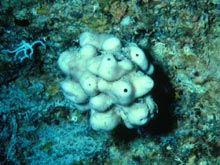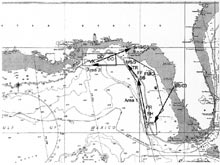
The deep-water sponge Discodermia is in clinical trials for the treatment of cancer. Click image for larger view.
Mission Plan: Medicines from the Deep Sea: Exploration of the Gulf of Mexico
Dr. Amy Wright, Dr. Shirley Pomponi,
and John K. Reed
Division of Biomedical Marine Research
Harbor Branch Oceanographic Institution
Potential Pharmaceuticals
Our primary objective is to explore for novel bioactive compounds from marine organisms that have potential as pharmaceutical products or biomedical research tools. The results of studies on the bioactivity and chemistry of novel compounds isolated from the samples collected during this expedition may be applied in the long term to the development of compounds used to study, diagnose and treat human diseases, including cancer, infectious diseases, diseases of the immune system, cardiovascular disease, and disorders of the central nervous system. Related to this primary objective is the development of alternative methods to harvesting from nature for production of bioactive compounds. We are actively engaged in research on chemical synthesis, microbial fermentation, marine invertebrate cell culture, combinatorial and molecular biology, and aquaculture of bioactive marine organisms.
Our second objective, which contributes to the first, is to document the biodiversity of the deep-water habitats (emphasizing sponges, cnidarians, mollusks, annelids, echinoderms, ascidians, and microorganisms) through underwater video and photographs, and museum specimens.
Our third objective is to facilitate educational and outreach programs using at-sea Web access, interactions with teachers, other educators, and the media, and data dissemination via the Internet.
Specific objectives include:
- collecting targeted benthic invertebrates for biomedical research using a remotely operated vehicle, scuba, and a support vessel
- documenting the biodiversity of deep-water, live-bottom benthic communities (for targeted taxa) with videotapes, photographs, and taxonomic museum specimens
- isolating and culturing microorganisms that live in association with deep-water marine invertebrates
- preparing extracts of macroorganisms and microorganisms for bioactivity screens
- preserving subsamples for our molecular genetics program, which encompasses both taxonomic evaluation and characterization of genes involved in secondary metabolite biosynthesis
- analyzing extracts for chemical activity with chromatography (TLC and/or HPLC)
- facilitating education and outreach activities in conjunction with NOAA Ocean Explorer (OE) through the OE Web site, media participation, and a teacher/education component
- providing an Internet-based database that will be developed in collaboration with NOAA OE.
2003 Target Sites

Proposed dive sites and cruise track in Gulf of Mexico: Area 1- PR= Pulley Ridge, SH= Sinkhole, FMG= Florida Middle Grounds, FF= Forty Fathom Ledge, TR= Twin Ridges, SB= Steamboat Lumps MPA, M&S= Madison and Swanson MPA; Area 2- VK= Viosca Knoll and Pinnacles, DD= Destin Dome, DC= Desoto Canyon. Click image for larger view.
Our primary focus will be to explore and document the biodiversity of benthic, live-bottom habitats at various deep-water sites (methane hydrate beds, deep-water live bottom, deep-water coral reefs, cold seeps, gas and oil seeps, salt domes, brine volcanoes, canyons, and deep-water sinkholes) in the Gulf of Mexico (GOM) to identify new resources with pharmaceutical potential. Based on our previous research in the GOM, Florida shelf, and western Atlantic, and our contacts at a wide variety of institutions, we have developed a database of 117 potential deep-water, live-bottom sites in the region. In addition, more than 4,000 oil and gas platforms are found in the northern GOM. These have provided an artificial habitat for many species of invertebrates and fishes. We will try to dive on some of these rigs to study fouling of the biological community.
This expedition will take place in the Gulf of Mexico, on the continental shelf and slope off Florida, Georgia, and Alabama (25º to 29ºN and 84º to 88ºW; depth 100-3,000 ft) and will examine deep-water Lophelia coral reefs, hard bottom, and live-bottom rock reefs, seeps, sinkholes, and oil rigs. Sites will be selected from the following areas:
- Area 1: Region of Pulley Ridge, Florida Middle Grounds, Steamboat Lumps Marine Protected Area (MPA), Madison and Swanson MPA, Twin Ridges, Forty Fathom Ledge, etc.; paleolithic limestone ledges, hard-bottom reefs, sinkhole, and deep-water Lophelia reefs and seeps; 100-3,000 ft.
- Area 2: Region of Viosca Knoll, the Pinnacles, Destin Dome, Desoto Canyon, etc.; deep-water Lophelia reefs, hard-bottom reefs, and oil rigs; 200-2,000 ft.





















